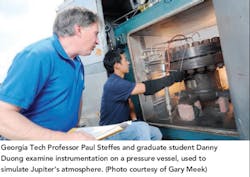Microwave Signatures Pinpoint Water On Jupiter
Jupiter has remained largely unchanged since its formation at the birth of the solar system. As a result, scientists hope that Juno will resolve unanswered questions about both the planet itself and how the solar system evolved. Among the key questions are how much water exists there and how that water evolved from the hydrogen-rich early solar system.
To detect and measure water, Juno will carry a radiometer that can measure radio emissions produced by the planet at microwave frequencies. As those signals pass through Jupiter's atmosphere, they are altered by water and other constituents. The probe will receive microwave signals at six different frequencies emitted at various levels of its atmosphere.
According to Paul Steffes, a Professor in Georgia Tech's School of Electrical and Computer Engineering and a member of the Juno Mission Team, the intensity of the microwave radiation at specific frequencies will grow weaker as a function of propagation loss due to water. By studying the responses at different frequencies, researchers will be able to tell whether there is water and at what altitudes it exists. To interpret that data, Steffes and his students are educating themselves by simulating the Jupiter atmosphere in their pressure vessel (see photo). That vessel is located inside an oven on the roof of Georgia Tech's Van Leer Building.
Through the laboratory atmospheric simulations, Steffes and his students can study the behavior of microwave signals passing through ammonia, hydrogen sulfide, helium, hydrogen, and water vapor at pressures up to 100 times greater than those of Earth. The researchers have made thousands of measurements with differing variables. The laboratory work is expected to be completed during 2012.
Beyond measuring water on Jupiter, Juno will study the planet's gravitation and magnetic fields. It will also look at the planet's polar areasa feat not previously accomplished.
